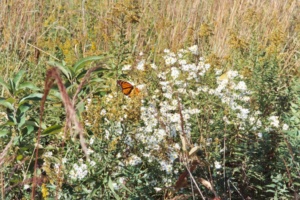Illinois Prairie


When the state of Illinois began selling land in this area for $1.25 an acre, around 1835, the settlers came and saw prairie and a few small groves of trees. What is prairie? It is grassland. A good part of Illinois was tall grass prairie then. It consisted of grasses like bluestem and many kinds of strong wild flowers like prairie smoke and Joe Pye-weed. Some of the flowers we now call weeds are really native plants such as goldenrod and Queen Anne’s lace. The grasses could be as high as ten feet and the soil they grew in was the richest in the country. That’s why farmers wanted to come here and grow crops like corn, wheat, and soy beans. Prairies were maintained by the animals that grazed on them like bison, elk, deer, and rabbits, and with prairie fires from lightning and native Americans about every five years. Prairie plants had deep roots and the fires traveled fast so they were not destroyed by these things, but quickly grew again. Land near the edges of the tree groves were settled first because wood was needed for building homes and for warmth and cooking. They had great difficulty plowing the dense prairie land. In 1837, that changed. John Deere invented the self-scouring steel bladed plow that could cut into prairie sod on a large scale. Within 50 years most of the prairie was converted to agriculture. Before settlement, 60% of Illinois was prairie; now less than 1% exists.
Where can you find prairie to visit today? Morton Arboretum and the Botanic Garden have sections of restored prairie. Spring Valley in Schaumburg Park District has a very nice section of prairie and also has Heritage Farm where you can see how early settlers lived and worked. There is a small piece of prairie thought to be original in Palatine. The Prairie Woods Audubon Society owns and takes care of it. The Palatine Prairie is near Quentin Road and Wood Street. It runs along the railroad tracks at the north end of the Reimer Reservoir. — Connie Rawa